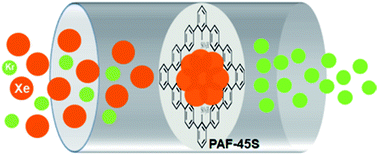Porous organic materials with ultra-small pores and sulfonic functionality for xenon capture with exceptional selectivity†
Abstract
We devise a new class of microporous materials termed porous organic frameworks for selective xenon capture from the pore-chemistry perspective. PAF-45S is target-synthesized with small pores of ∼5.2 Å whose pore surface is engineered with sulfonate groups by a post-modification method. Adsorption measurements demonstrate that PAF-45S possesses a higher xenon uptake (41.5 cm3 g−1) than krypton uptake (12.2 cm3 g−1) at 101 kPa and 298 K. Henry’s law predicts that a selectivity of 16.7 for Xe over Kr is expected. Experimental and simulation studies show that xenon is more strongly adsorbed on PAF-45S than krypton, evidenced by a higher heat of xenon adsorption (31 and 19 kJ mol−1 for Xe and Kr respectively) and larger binding energy (−9.54 and −6.98 kJ mol−1 for Xe and Kr). The selective adsorption of PAF-45S for xenon results from the synergistic contributions of small pore size and sulfonic functionality by an optimization of the interaction between xenon molecules and the PAF-45S framework. Furthermore, actual Xe/Kr separations are mimicked by breakthrough measurements using a ternary gas mixture of Xe, Kr and N2. The results show that PAF-45S exhibits unprecedentedly high Xe/Kr selectivity (24.1) and good Xe adsorption capacity (0.053 mmol g−1). Its high separation performance together with excellent stability and reproducibility promise PAF-45S as a next-generation material in the adsorption separation technology.



 Please wait while we load your content...
Please wait while we load your content...